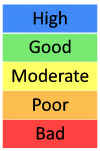The Water Framework Directive (2000/60/EC, WFD) aims to protect surface (rivers, lakes), groundwater, transitional and coastal water resources within the EU
and to create a framework for integrated and sustainable water resource management. The general objective set by the WFD is to achieve “good status” for all aquatic ecosystems by 2015 (the end of the first management cycle) and to prevent further deterioration. To meet this objective, EU member states are required to take a variety of actions including establishing monitoring networks for continuous monitoring of water resources in terms of quality and quantity, development of River Basin Management Plans (RBMPs) together with targeted Programs of Measures (PoMs), public participation etc.
Achieving a good status
For surface water bodies the “status” of a water body is determined by the “ecological status” and the “chemical status”:
- “Ecological status”
- The ecological status indicates the “health” of an aquatic ecosystem. As described in Annex V of the WFD, the ecological status reflects the quality of the biological community, its structure and functions. A number of biological and abiotic elements (supporting the biological elements) are assessed to estimate the ecological status.
- “Chemical status”
- The chemical status is determined based on compliance with the quality standards set at a European level for a series of chemical substances (Environmental Quality Substances – EQSs) and on the presence of Priority Hazardous Substances
* Heavily Modified Water Bodies (HMWBs) are exempted from achieving “good status”. For HMWBs the WFD environmental objective is achieving “good ecological potential”
Estimating the ecological status

To estimate the ecological status for surface water bodies each biological element is assessed and categorized in a five class scale ranging from “high” to poor” representing deviation from natural conditions. Subsequently the overall ecological status is estimated based on the same five class scale. The WFD uses a “one out all out” principle, upon which the overall status is determined by the worst status that was estimated for any of the quality elements.
For more information visit the current project’s website.
